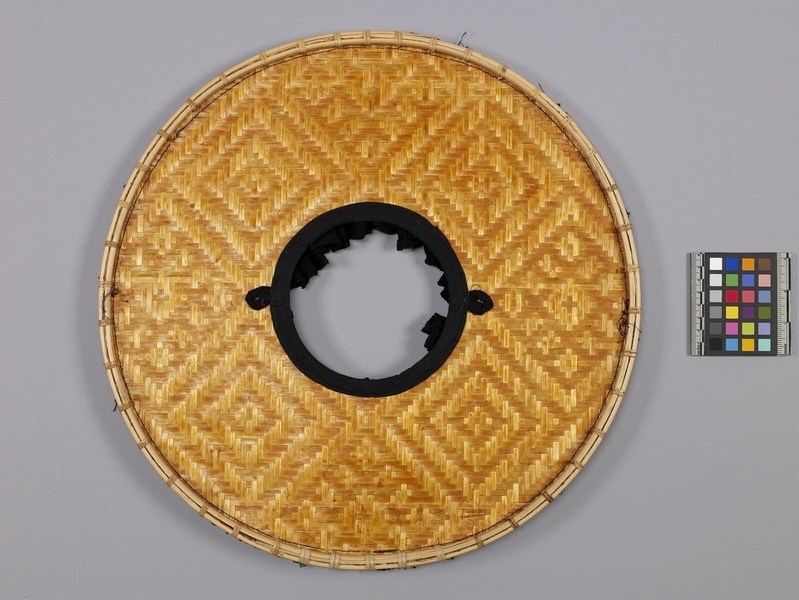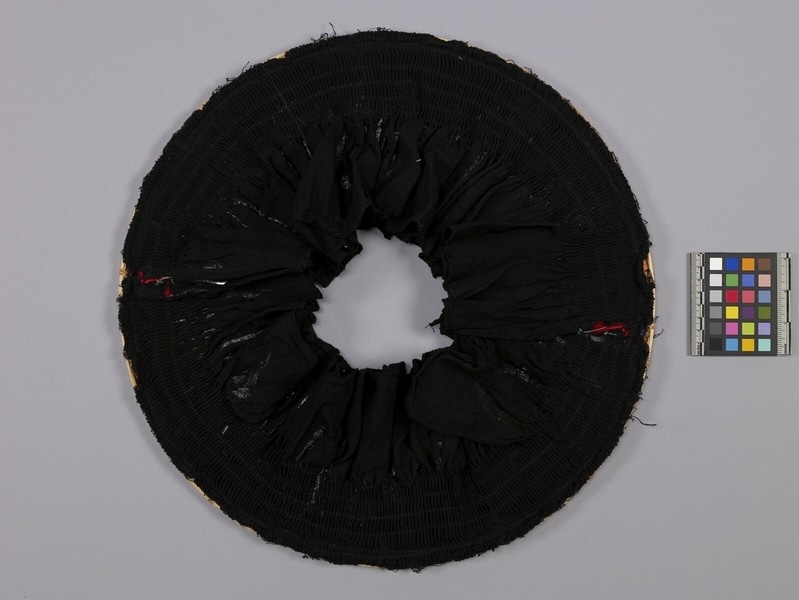Hat Item Number: Edz900 from the MOA: University of British Columbia


Description
A flat hat of twill-weave straw with natural yellow and yellow-green colours and varnished. Hat is disc shaped with a round hole in the centre and finished with a band of black cloth with two diametrically opposed black cloth loops. Outer circumference is finished with a double rim of split bamboo affixed to the upper side of the hat with split rattan. Two pieces of thin, black cotton, 18 cm. wide, finely pleated and joined together with loose stitches of red and green thread.
History Of Use
Worn while working outdoors to protect wearer from sun and dust. Often considered an identifying feature of Hakka women in this region. The band, Hakka women wear as an ornament on their hats, indicates their marital status (by colour) and place of origin (by length and material of tassels, by colour combinations, and mode of wearing). (collector)
Cultural Context
Worn by Hakka women, sometimes worn by Cantonese women.
Iconographic Meaning
Black colour of band indicates that the wearer is either elderly or unmarried.
Narrative
This hat was new when collected in Yuen Long Old Market, Hong Kong, in 1976. Hakka people are one of the two original land-dwelling groups that settled the area that became the New Territories of Hong Kong. Their spoken language, and some customs, differed from those of the other original group, the Cantonese or Punti. The Cantonese arrived first and settled on the best rice-growing lands, while the Hakka began to arrive after the late 17th century and settled the more hilly lands.
Item History
- Made in Hong Kong, China before 1976
- Collected during 1976
- Owned by Elizabeth L. Johnson before September 2, 1976
- Received from Elizabeth L. Johnson (Donor) on September 2, 1976
What
- Name
- Hat
- Identification Number
- Edz900
- Type of Item
- hat
- Material
- synthetic fibre, tung oil lacquer, cotton fibre, rattan, bamboo grass and grass
- Manufacturing Technique
- woven, spun, split and machine stitched
- Overall
- height 6.5 cm, diameter 42.0 cm
Who
- Culture
- Chinese: Hakka
- Previous Owner
- Elizabeth L. Johnson
- Received from
- Elizabeth L. Johnson (Donor)
Where
- Holding Institution
- MOA: University of British Columbia
- Made in
- Hong Kong, China
When
- Creation Date
- before 1976
- Collection Date
- during 1976
- Ownership Date
- before September 2, 1976
- Acquisition Date
- on September 2, 1976
Other
- Item Classes
- textiles
- Condition
- fair
- Accession Number
- 0328/0001